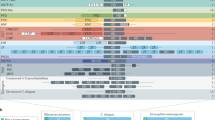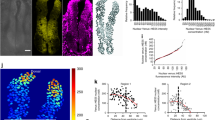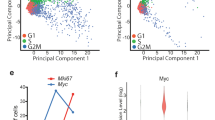Abstract
THE development of a multicellular organism involves a delicate balance among the processes of proliferation, differentiation and death. Naturally occurring cell death aids tissue remodelling, eliminates supernumerary cell populations and provides structural elements such as hair and skin. In the nervous system, selective cell death contributes to the formation and organization of the spinal cord and sympathetic ganglia1, retina2 and corpus callosum3. But cell death also occurs in several neuropathological conditions, such as amyelotrophic lateral sclerosis4 and Alzheimer's disease5. Therefore an elucidation of the mechanisms responsible for cell death is critical for an appreciation of both normal development and neuropathological disorders. Using a fos-lacZ transgenic mouse6, we provide evidence showing that the continuous expression of Fos, beginning hours or days before the morphological demise of the cell, appears to be a hallmark of terminal differentiation and a harbinger of death.
This is a preview of subscription content, access via your institution
Access options
Subscribe to this journal
Receive 51 print issues and online access
$199.00 per year
only $3.90 per issue
Buy this article
- Purchase on Springer Link
- Instant access to full article PDF
Prices may be subject to local taxes which are calculated during checkout
Similar content being viewed by others
References
Hamburger, V. & Oppenheim, R. W. Neurosci. Comment. 1, 39–55 (1982).
Wong, R. O. L. & Hughes, A. J. comp. Neurol. 262, 496–511 (1987).
Hankin, M. H., Schneider, B. F. & Silver, J. J. comp. Neurol. 272, 191–202 (1988).
Plaitakis, A. Ann. Neurol. 28, 3–8 (1990).
Snider, W. D. & Johnson, E. M. Ann. Neurol. 26, 489–506 (1989).
Smeyne, R. J. et al. Neuron 8, 13–23 (1992).
Dony, C. & Gruss, P. Nature 328, 711–714 (1987).
Buttyan, R., Zakeri, Z., Lochshin, R. & Wolgemuth, D. Molec. Endocrin. 2, 650–657 (1988).
Gonzales-Martin, C., de Diego, I., Crespo, D. & Fairen, A. Devl Brain Res. 68, 83–95 (1992).
Colotta, F., Polentarutti, N., Sironi, M. & Mantovani, A. J. biol. Chem. 267, 18278–18283 (1992).
Williams, P. L., Warwick, R., Dyson, M. & Bannister, L. H. Gray's Anatomy (Churchill Livingstone, Edinburgh, 1989).
Greene, R. M. & Pratt, R. M. J. Embryol. exp. Morph. 36, 225–245 (1976).
Shuler, C. F., Halpern, D. E., Guo, Y. & Sank, A. C. Devl Biol. 154, 318–330 (1992).
Olney, J. W. in Kainic Acid as a Tool in Neurobiology (eds McGeer, E. G., Olney, J. W. & McGeer, P. L.) 95–121 (Raven, New York, 1978).
Schwob, J. E., Fuller, T., Price, J. L. & Olney, J. W. Neuroscience 5, 991–1014 (1980).
Caviness, V. S. Jr. & Rakic, P. A. Rev. Neurosci. 1, 297–326 (1978).
Smeyne, R. J. & Goldowitz, D. J. Neurosci. 9, 1608–1620 (1989).
Davies, A. M. Development 100, 185–208 (1987).
Grant, G. in The Rat Nervous System (ed. Paxinos, G.) 303–309 (Academic, Sydney, 1985).
Yip, H. K. & Johnson, E. M. Jr. Proc. natn. Acad. Sci. U.S.A. 81, 6245–6249 (1984).
Ross, W. et al. Cancer Res. 44, 5857–5860 (1984).
Evan, G. I. et al. Cell 69, 119–128 (1992).
Morgan, J. I. & Curran, T. A. Rev. Neurosci. 14, 421–451 (1991).
Johnson, R. S., Spiegelman, B. M. & Papaioannou, V. Cell 71, 577–586 (1992).
Wang, Z. Q. et al. Nature 360, 741–745 (1992).
Oberdick, J., Smeyne, R. J., Mann, J. R., Zackson, S. & Morgan, J. I. Science 248, 223–226 (1990).
Laird, P. W. et al. Nucleic Acids Res. 19, 4293–4295 (1991).
Fearon, E. R., Hamilton, S. R. & Vogelstein, B. Science 238, 193–197 (1987).
Author information
Authors and Affiliations
Rights and permissions
About this article
Cite this article
Smeyne, R., Vendrell, M., Hayward, M. et al. Continuous c-fos expression precedes programmed cell death in vivo. Nature 363, 166–169 (1993). https://doi.org/10.1038/363166a0
Received:
Accepted:
Issue Date:
DOI: https://doi.org/10.1038/363166a0
This article is cited by
-
Effect of BRD4 Inhibitor on Cognitive Deficit and c-Fos /BDNF level in rats with Alzheimer's disease
Neuroscience and Behavioral Physiology (2023)
-
Spinal Cord Injury Increases Pro-inflammatory Cytokine Expression in Kidney at Acute and Sub-chronic Stages
Inflammation (2021)
-
Anticonvulsive activity of (1S)-(−)-verbenone involving RNA expression of BDNF, COX-2, and c-fos
Naunyn-Schmiedeberg's Archives of Pharmacology (2017)
-
AP1 transcription factors are required to maintain the peripheral taste system
Cell Death & Disease (2016)
-
Up-Regulation of c-Fos Associated with Neuronal Apoptosis Following Intracerebral Hemorrhage
Cellular and Molecular Neurobiology (2015)
Comments
By submitting a comment you agree to abide by our Terms and Community Guidelines. If you find something abusive or that does not comply with our terms or guidelines please flag it as inappropriate.



